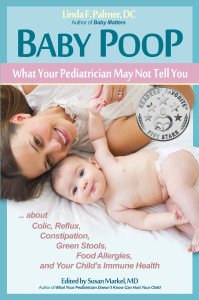First published on Motherhood Moment May27, 2015

Parents spend great amounts of time worrying about what goes into their babies. All the while, what shows up in baby’s diapers can provide tremendous clues about baby’s digestion, immune functioning, and overall wellness.
This is most valuable because we don’t get explanations or even pointing fingers from babies: We get smiles or tears, and we get poop. The appearance and behavior of a child’s stools can give more information about a child’s health than any other factor. Really? What can baby’s poop tell about his health?
Learning what normal ranges are expected for your baby’s age and diet—then becoming familiar with your own baby’s normal—are key to recognizing when something is off.
Baby’s first stools are important ind icators that food is indeed going in and that there’s a working digestive system. Once we know that ample milk transfer is occurring and that digestion and elimination are in gear, the appearance of a young baby’s stools can especially signify how well she is tolerating her diet. After the meconium clearing, watery, possibly seedy, mustard colored stools are a sign of good health in exclusively breastfed babies. Toothpaste-textured mustard to tan colored poops are a sign of good formula tolerance in a baby who receives any formula.
icators that food is indeed going in and that there’s a working digestive system. Once we know that ample milk transfer is occurring and that digestion and elimination are in gear, the appearance of a young baby’s stools can especially signify how well she is tolerating her diet. After the meconium clearing, watery, possibly seedy, mustard colored stools are a sign of good health in exclusively breastfed babies. Toothpaste-textured mustard to tan colored poops are a sign of good formula tolerance in a baby who receives any formula.
Watery stools of increased frequency can, of course, signify illness, and baby’s temperature and behavior can help make this determination. Regular appearances of watery explosions, stools that are infrequent or hard, or a mix of these two presentations can be signs of food intolerance, whether to foods in breastfeeding mother’s diet or to ingredients in baby’s formula. Other factors can cause these stool irregularities as well.
Except upon the introduction of formula or solid foods, any variance in the color of baby’s stools also indicates that something’s off—from a slight irritation to a dangerous disorder. The most common color variance is green—from a brilliant lime green to a dark forest green. The darkest black-green generally arises from iron supple mentation or high iron formula. This appearance indicates that less iron could likely be given since it’s being lost to the stool and probably causing harder stools. Lighter greens are usually bile and signify that baby’s food is being rushed through too quickly for complete digestion to take place. Sometimes a lactation specialist notices a feeding irregularity that can easily be corrected. Most often this occurs from a sensitivity to some food or foods in mom’s diet or to some ingredients in baby’s formula. Cow’s milk is the most common irritant. A temporary bought of green stools can also result from a little intestinal virus, from teething, or from grape Pedialyte.
mentation or high iron formula. This appearance indicates that less iron could likely be given since it’s being lost to the stool and probably causing harder stools. Lighter greens are usually bile and signify that baby’s food is being rushed through too quickly for complete digestion to take place. Sometimes a lactation specialist notices a feeding irregularity that can easily be corrected. Most often this occurs from a sensitivity to some food or foods in mom’s diet or to some ingredients in baby’s formula. Cow’s milk is the most common irritant. A temporary bought of green stools can also result from a little intestinal virus, from teething, or from grape Pedialyte.
Other stool color changes can provide clues about concerns from a bile duct obstruction (gray or white) to malabsorption (orange); from an intestinal obstruction (jelly red) to bleeding high in the digestive tract (black) or bleeding in the lower bowels (red blood).
Colic, reflux, and eczema are seen far more often in the industrialized world than in developing nations. Food intolerances or allergies are the chief instigators of these and baby’s poops give the biggest clues. Deeper consequences of industrialization are then at the root of such food sensitivities. An unhealthy gut flora is but one of many causes—and one of many results of industrialized living. Babies typically have exposures both in-utero and after birth to multitude chemicals including plasticizers, pesticides, mercury, fluoride, fire retardants, dry cleaning fluids; the list goes on. These can disrupt baby’s healthy flora development, immune system integrity, daily hormonal rhythms, and stress-handling hormone responses. Common interferences in normal birth have well-proven detrimental consequences. Exposure at birth to undesirable hospital flora, cesarean births, antibiotics given to mothers, and delayed first breastfeedings all prevent the best initial bacterial colonization of baby’s system and can also disrupt hormonal regulation.
When not addressed with gut healing measures, babies with colic, reflux, sleeplessness, and rashes often grow into children with asthma, allergies, autism, and irritable bowels, and far-too-frequently grow into adults with diabetes, arthritis, or other autoimmune disorders.
By paying attention to the messages in baby’s diapers, parents can be alerted that their child is vulnerable and act to reduce gut irritations and promote gut healing. In this way, working to correct those early stool irregularities can help to prevent long term chronic disorders.

[…] babyreference.com 忌避剤をつけることのできない赤ちゃんは、ベビーカーにモスキートネットをぴったりと付けたり、蚊帳を利用します。 […]